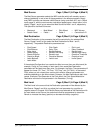
Chapter 7: Editing Effects
REVERB PARAMETERS
Use the [PAGE ] button to advance the display through the remaining pages of the
Reverb function. However, you must have the correct effect send selected (1–4) in
order to get at the Reverb parameters (in Config. #1, the Reverb parameters are
found only on effect send 1; in Config. #2, they are found on sends 1 and 3 since
there are two separate Reverbs). Here you will find parameters for selecting the
Reverb type, adjusting Pre-Delay Time and Pre-Delay Mix.
Reverb Type (7 types) Page 5
The QS has seven different reverb types, all stereo, each of which simulates a
different space or produce a different ambient effect. The different Reverb types are:
Plate 1 & 2. The two Plate reverb types simulate an artificial device known as a
Plate. In the early days of recording, Plates were extremely popular because they
were almost the only way to provide any sort of artificial ambiance to a recording. The
sound of a well-tuned Plate has become quite popular over the years especially when
used on vocal or drum sounds. The two Plate reverbs differ in subtle tonal
characteristic changes such as those found in different manufacturers’ plate reverbs.
Room. The Room reverb type simulates not only rooms of different sizes, but rooms
with different surface materials. A room with soft surfaces such as carpet will produce
a reverberant sound with much less high end (treble) than a room with hard surfaces.
This reverb type can easily simulate both examples and many, many more.
Hall. Much larger than a room, Halls are characterized by their high ceilings, irregular
shapes, and generally uniform density of reflections.
Large. Much larger than a hall, this reverb type emulates large ambient spaces such
as amphitheaters, gymnasiums, etc.
Gate. Gated Reverb is a very popular effect on drums first found on English records
in the early 1980s. This reverb type can simulate applying a noise gate (a device that
automatically decreases the volume once the signal falls below a certain level) across
the output of the reverb thereby causing the initial attack of the reverb to sound very
big, but the tail of the reverb to be cut off very quickly. Although this effect is not
found in nature, it works great for modern drums, percussion, and any quickly
repeated, transient source.
Reverse. The Reverse Reverb type is an inverted reverb in which the volume
envelope is reversed. This means that the signal begins softly but grows louder until it
is cut off, rather than loud to soft as normal.
Pre-Delay Time (0 to 299ms) Pages 6 & 7
Pre-Delay is the slight delaying of the Reverb itself so that the dry signal more easily
stands out from the Reverb. A bit of Pre-Delay can sometimes make certain
instruments (such as snare drums) sound bigger. Use page 6 to adjust the Pre-Delay
Time in 10ms intervals, and/or use page 7 to adjust the Pre-Delay Time in 1ms
intervals. This Pre-Delay is part of the Reverb itself; don’t confuse it with the separate
Delay modules available under the Delay function.
108 QS7/QS8 Reference Manual





















